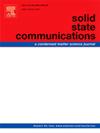X-ray absorption near edge structure of bulk and two-dimensional Na2Po: A testbed for scientific research
IF 2.1
4区 物理与天体物理
Q3 PHYSICS, CONDENSED MATTER
引用次数: 0
Abstract
Disodium Polonide in its two-dimensional phases are well-examined and have exceptional structural, electronic, vibrational, optical and thermoelectric properties. Utilizing WIEN2k DFT simulation software the ground state attributes of 1T and 1H phases of Na2Po are computed and in both the phases it possesses structural and vibrational stability. Additionally, the thermal stability of 1T and 1H phases of Na2Po was carried out by Ab- Initio molecular dynamics (AIMD) in the NVT ensemble for 3 different temperatures 300 K, 600 K and 1000 K up to 3ps with a time step of 1 fs. Both 1T and 1H phases of Na2Po are thermally stable. Moreover, 1T and 1H-Na2Po may have profound UV protectant and UV photodetectors that are briefly studied through their optical responses. The thermoelectric properties were carried out with BoltzTraP code for both phases. The figure of merit (ZT) at 300K of 1T-Na2Po and 1H-Na2Po is found to be 0.756 and 0.640, respectively. Hence, 1T-Na2Po is more suitable than 1H-Na2Po to design a waste heat recovery system. The XANES calculation was performed for Po LIII edge of both 3D and 2D (1T and 1H) phases of Na2Po.
求助全文
约1分钟内获得全文
求助全文
来源期刊

Solid State Communications
物理-物理:凝聚态物理
CiteScore
3.40
自引率
4.80%
发文量
287
审稿时长
51 days
期刊介绍:
Solid State Communications is an international medium for the publication of short communications and original research articles on significant developments in condensed matter science, giving scientists immediate access to important, recently completed work. The journal publishes original experimental and theoretical research on the physical and chemical properties of solids and other condensed systems and also on their preparation. The submission of manuscripts reporting research on the basic physics of materials science and devices, as well as of state-of-the-art microstructures and nanostructures, is encouraged.
A coherent quantitative treatment emphasizing new physics is expected rather than a simple accumulation of experimental data. Consistent with these aims, the short communications should be kept concise and short, usually not longer than six printed pages. The number of figures and tables should also be kept to a minimum. Solid State Communications now also welcomes original research articles without length restrictions.
The Fast-Track section of Solid State Communications is the venue for very rapid publication of short communications on significant developments in condensed matter science. The goal is to offer the broad condensed matter community quick and immediate access to publish recently completed papers in research areas that are rapidly evolving and in which there are developments with great potential impact.
 求助内容:
求助内容: 应助结果提醒方式:
应助结果提醒方式:


